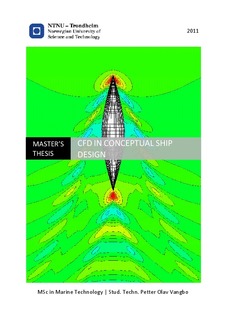| dc.contributor.author | Vangbo, Petter Olav | nb_NO |
| dc.date.accessioned | 2014-12-19T12:06:35Z | |
| dc.date.available | 2014-12-19T12:06:35Z | |
| dc.date.created | 2012-02-07 | nb_NO |
| dc.date.issued | 2011 | nb_NO |
| dc.identifier | 492068 | nb_NO |
| dc.identifier.uri | http://hdl.handle.net/11250/237948 | |
| dc.description.abstract | Computational Fluid Dynamics (CFD) has been around for many years. It is a computer tool that can be used to find the hydrodynamic fluid performances. In ship design it is used in a wide area from smoke propagation to resistance estimations. It is however in resistance estimations that CFD have had most focus and research.
There are many tools a designer can make use of nowadays. Most of the tools are computer based. This is optimization algorithms, computer aided design (CAD) and computational fluid dynamics (CFD). Using the tools should shorten the time of ship design and make better solutions. I have used a computer tool that mixes optimization with model variation (CAD) and verification (CFD). My conclusion is that it is a powerful tool to use, but should be handled with care. Few variables in the optimization process are important.
Conceptual design methodology could be broken down to two outer ranges; point based design and set based design. The methods are quite different when approaching a complex design problem. There seems to be some favor in set based design when coming to a global ‘optimized’ solution to the design problem. More knowledge is gathered in set based design before deciding the final requirements and parameters. This is especially in new developing design where little knowledge is produced in the past.
CFD is a broad term. There is many different methods and area of use. In this thesis I will break it down to two terms; potential codes and RANSE codes. Potential codes are easy, robust and well developed. RANSE codes are difficult, takes a lot of time and not so well developed. Potential codes are used in areas where turbulent flows are not present, while RANSE codes are used when it is present and important to the result.
If designing new innovative hulls CFD should be used earlier in the design process and with a simulation driven design approach. Simulation driven design could be used with potential codes or RANSE codes. To have a high value rate of the modeling potential codes should be used when many sets of variation I needed and turbulence is not important to the answers. RANSE code should be used when turbulent flow is important to the answer, but must be done with few sets of variations because of high computational effort.
If designing a more standard ship, CFD should be used in a modeling design approach to verify the performance estimations that have been done earlier in the process. | nb_NO |
| dc.language | eng | nb_NO |
| dc.publisher | Norges teknisk-naturvitenskapelige universitet, Fakultet for ingeniørvitenskap og teknologi, Institutt for marin teknikk | nb_NO |
| dc.title | CFD in conceptual ship design | nb_NO |
| dc.type | Master thesis | nb_NO |
| dc.contributor.department | Norges teknisk-naturvitenskapelige universitet, Fakultet for ingeniørvitenskap og teknologi, Institutt for marin teknikk | nb_NO |
